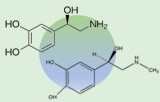Epinephrine and Norepinephrine are chemical messengers that play crucial roles in the body as both neurotransmitters and hormones. They are key components of the body’s “fight-or-flight” response, preparing the body to respond to stress. While they have similar functions, they also exhibit some key differences.
Functions and Effects
Fight-or-Flight Response: Both epinephrine and norepinephrine trigger the fight-or-flight response by increasing heart rate, blood pressure, and energy levels to help the body respond quickly to perceived threats.
Blood Pressure Regulation: Norepinephrine primarily maintains or raises blood pressure by constricting blood vessels, whereas epinephrine can also elevate blood pressure.
Heart Rate: Epinephrine generally has a stronger effect on increasing heart rate, while norepinephrine’s influence is more pronounced on blood vessels.
Blood Sugar Levels: Epinephrine increases blood sugar levels, supplying extra energy during stressful situations.
Airways: Epinephrine relaxes the smooth muscles in the airways, thereby improving breathing.
Focus and Alertness: Norepinephrine enhances attention and overall focus.
Kidney Function: Both hormones reduce blood flow to the kidneys during stress.
Synthesis and Release
Norepinephrine: Synthesized from dopamine within nerve axons and the adrenal medulla, norepinephrine is released as both a neurotransmitter and a hormone.
Epinephrine: Formed from norepinephrine in the adrenal medulla, epinephrine is primarily secreted as a hormone in response to stress.
Medical Uses
Norepinephrine: Used clinically to raise and maintain blood pressure in acute scenarios such as cardiac arrest and septic shock.
Epinephrine: Employed in the treatment of low blood pressure, severe allergic reactions (anaphylaxis), asthma attacks, and cardiac arrest.
Receptors
Norepinephrine: Acts mainly on alpha receptors, which leads to vasoconstriction.
Epinephrine: Interacts with both alpha and beta receptors, thereby eliciting a broader range of physiological effects.


